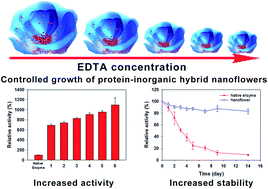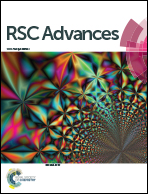Controlled synthesis of an enzyme–inorganic crystal composite assembled into a 3D structure with ultrahigh enzymatic activity†
Abstract
In this study, we report a method for the controlled synthesis of an enzyme–inorganic crystal composite assembled into a 3D structure with flower-like shape, which shows an ultrahigh enzymatic activity. Using ethylenediaminetetraacetic acid (EDTA) as the chelating compound, the addition of a protein aqueous solution in phosphate saline buffer into a water solution containing Cu(II) resulted in a 3D architecture made of protein and flower-like shaped copper phosphate crystals with controllable size ranging from approximately 1 μm to 15 μm. The incorporated laccase showed ultrahigh activity, which was about 7–11 times higher compared to free laccase in solution. The immobilized laccase–copper phosphate hybrid microflowers can be applied for rapid and sensitive detection of phenol in water. Repeated use of immobilized laccase microflowers was demonstrated for 60 cycles during a period of two months.


 Please wait while we load your content...
Please wait while we load your content...